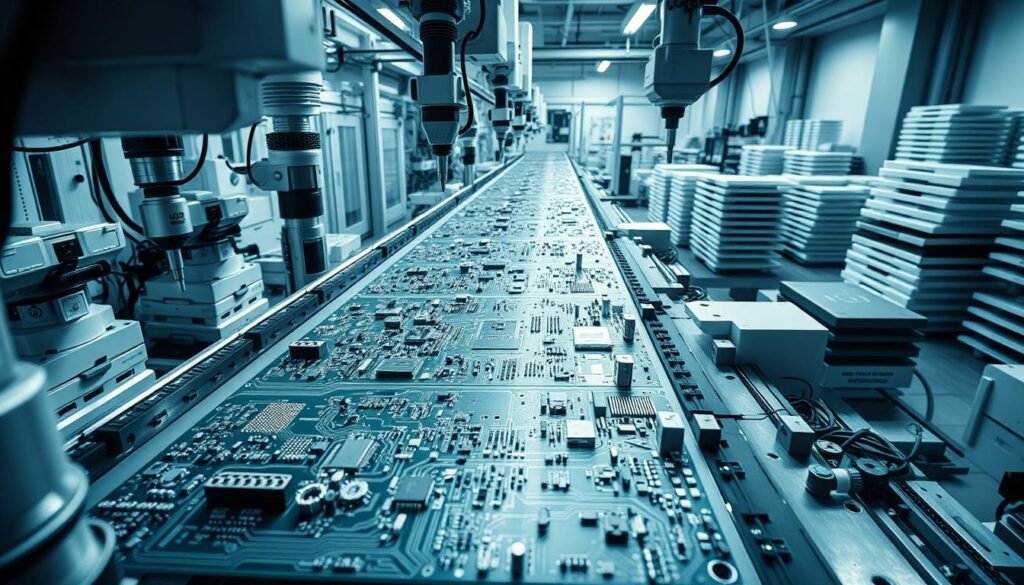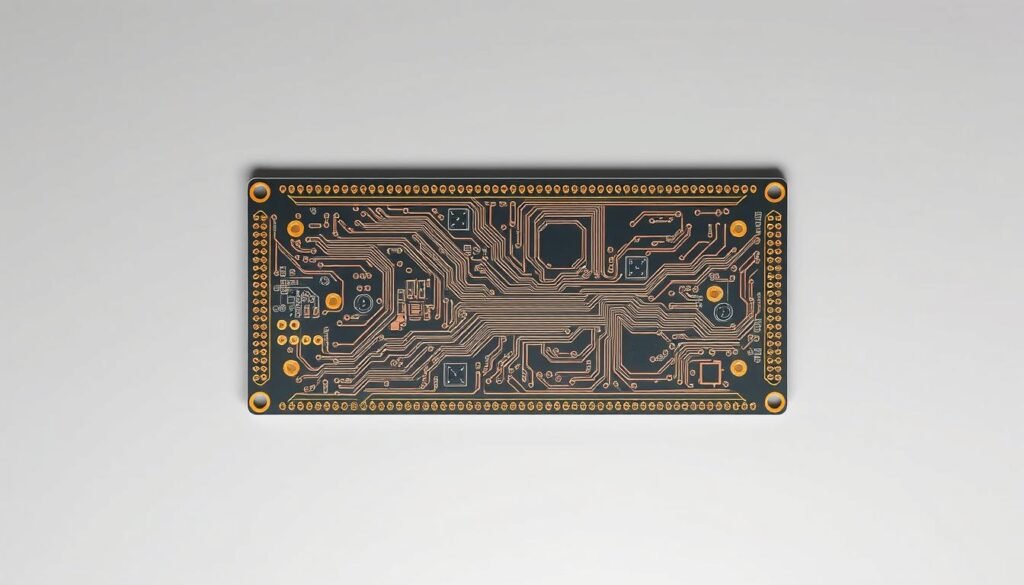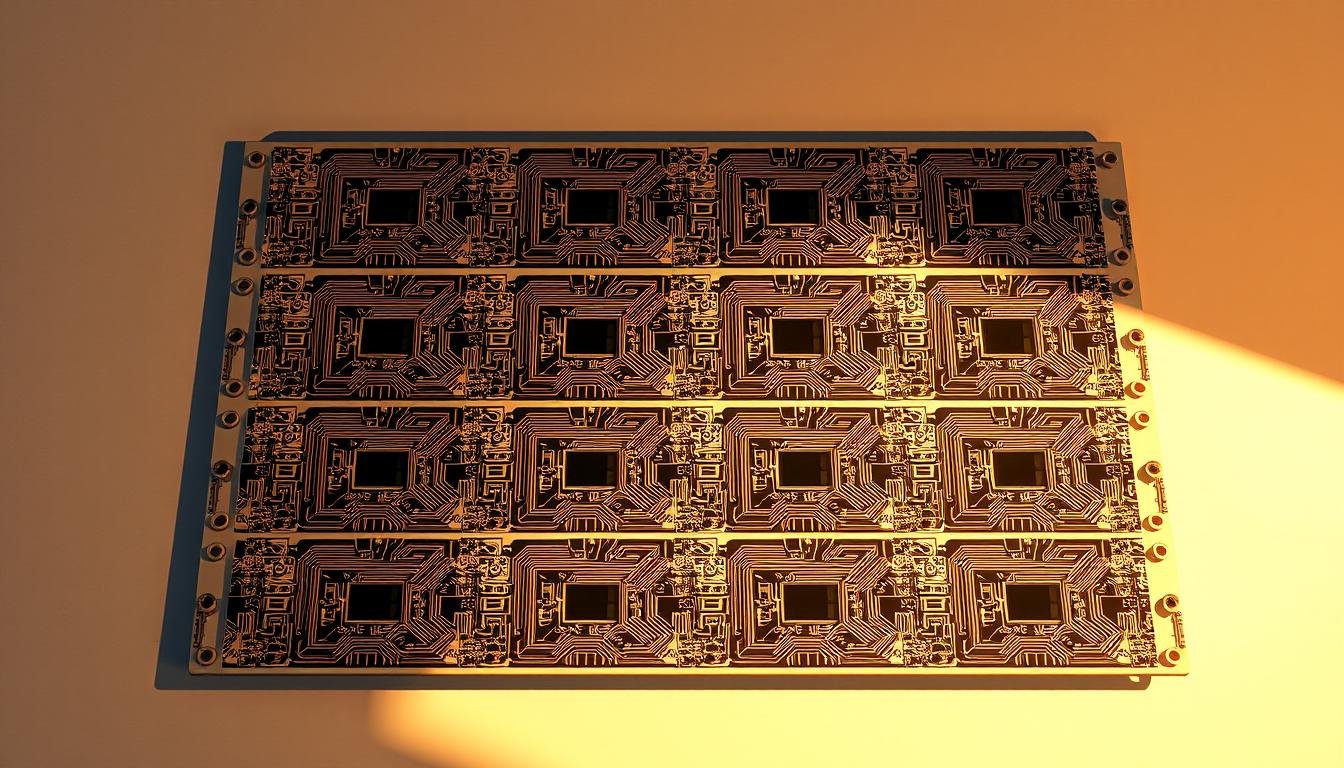Imagine transforming your circuit board production from a costly, time-consuming task into a streamlined powerhouse. The secret lies in a technique rooted in manufacturing history yet perfected for modern electronics. By grouping multiple designs onto single panels, manufacturers achieve unprecedented efficiency – but only when executed correctly.
We’ve seen companies reduce handling time by 40% through strategic panel design. This approach mirrors early duplication methods but leverages today’s automated assembly lines. Standard 18″x24″ panels dominate the industry, yet custom configurations often unlock hidden savings for specialized projects.
This guide reveals how proper layout planning impacts every production stage. From component placement accuracy to material utilization rates, small design choices create ripple effects across manufacturing timelines. We’ll explore why some panels fail during depaneling while others glide through assembly flawlessly.
Key Takeaways
- Panelization cuts production costs by maximizing material use and reducing machine setup time
- Modern techniques evolved from 20th-century duplication methods to support automated assembly
- Optimal panel designs prevent board damage during separation while improving component accuracy
- Strategic breakaway tab placement can reduce post-processing labor by up to 25%
- Custom panel sizes often yield better results than sticking strictly to industry standards
Understanding PCB Panelization and Its Role in Modern Manufacturing
Efficiency in production isn’t a modern concept—it’s built on centuries of inventive problem-solving. The 1803 polygraph machine demonstrated how duplicating documents could double output with minimal effort. This principle now drives printed circuit board manufacturing, where grouping multiple designs onto single panels revolutionized electronics fabrication.
Evolution of Panel Fabrication
Early circuit board production required manual handling of individual units. Automated systems changed this by adopting standardized panels that fit modern equipment. Today’s pick-and-place machines and soldering systems work best with 18″x24″ panels, though custom sizes often improve material use.
| Production Era | Handling Method | Output Capacity |
|---|---|---|
| Pre-1980s | Manual single-board | 50 units/hour |
| Modern Automated | Panel-based | 1,200 units/hour |
Impact on Production Processes
Panelization enables factories to implement Industry 4.0 practices. Sensors track entire panels during assembly, reducing defects by 18% compared to single-board processing. This approach also supports lean manufacturing:
- 40% less material waste through optimized layouts
- 55% faster machine setup times
- 30% improvement in equipment effectiveness
Automated depaneling systems now complete in minutes what once took hours of manual labor. This evolution from individual handling to panel-based workflows makes high-volume electronics assembly economically viable for mass markets.
Key Benefits and Common Challenges in PCB Panelization

Modern electronics manufacturing thrives on precision and scale, where every second and millimeter counts. Grouping multiple circuit boards into panels unlocks significant advantages while introducing unique technical considerations.
Enhanced Manufacturing Efficiency
Automated assembly lines achieve peak performance with panelized boards. Our data shows:
| Factor | Single Boards | Panelized |
|---|---|---|
| Handling Time | 8.2 min/unit | 1.3 min/unit |
| Placement Accuracy | ±0.1 mm | ±0.02 mm |
| Material Use | 72% | 94% |
This structured approach reduces machine idle time by 55% compared to individual processing. For cost-effective PCB manufacturing, panelization typically cuts per-unit expenses by 30-40% through optimized substrate use.
Overcoming Depanelization Risks
Separating boards without damaging components requires careful planning. We recommend:
- Maintaining 1.5 mm clearance from edges for sensitive parts
- Using mouse bites instead of V-grooves for dense layouts
- Specifying 0.8 mm minimum tab thickness
Proper techniques reduce stress fractures by 78% in our stress tests. Automated laser cutting systems now achieve separation speeds of 120 boards/minute with near-zero defect rates.
Panelization: How to Optimize Your PCB Layout for Mass Production

Smart design choices become economic multipliers when preparing boards for panel production. Early decisions about board geometry and component organization directly influence material costs and assembly precision.
Design Considerations for Fabrication
We reshape standard layouts to maximize panel efficiency. Rounding board corners allows tighter nesting, while rectangular designs with 45° rotations often yield better material use. Consider these configurations:
| Design Type | Material Usage | Cost Reduction | Units/Panel |
|---|---|---|---|
| Single Design | 82% | 12% | 24 |
| Mixed Designs | 94% | 28% | 36 |
Combining different boards with matching layer stacks cuts waste dramatically. A recent project achieved 31% cost savings by pairing main boards with test fixtures on shared panels.
Strategic Component Placement
Components near panel edges require special attention. We follow three core rules:
- Keep sensitive parts 2.5 mm from depaneling lines
- Cluster tall components at panel center
- Align connectors parallel to break tabs
This approach prevents damage during separation while maintaining signal integrity. Automated optical inspection (AOI) compatibility improves when test points follow panel grid patterns rather than individual board layouts.
Design Guidelines and Best Practices for PCB Panels
Precision engineering meets manufacturing reality when defining spacing and alignment rules. We implement three non-negotiable principles: adequate clearances, strategic tooling placement, and machine-readable alignment markers.
Spacing, Clearance, and Tab Routing
Border zones make or break panel integrity. Maintain 10-15 mm edge margins for handling equipment and tooling holes. Between boards, 2-3 mm gaps prevent stress fractures during separation.
Critical component setbacks:
- 0.125″ from breakout tabs (0.250″ for tall capacitors)
- 0.050″ from V-groove edges (0.125″ for elevated parts)
- 0.020″ copper-free zones near cutting lines
Tab routing demands precision. We specify 0.8-1.2 mm perforation diameters with 4-6 drill points per connection. This balances structural stability with clean breakaway performance.
Fiducials and Tooling Hole Placement
Automated assembly relies on flawless reference points. Place three fiducials per board – triangular patterns work best. These 1 mm copper markers require 3 mm clearance from other features.
| Feature | Size | Location |
|---|---|---|
| Tooling holes | 3.2 mm | Panel corners (±0.1 mm) |
| Fiducials | 1 mm | Board corners (3 mm inset) |
For mixed-design panels, follow design guidelines that standardize hole placement across variants. This prevents machine recalibration between batches, saving 12-18 minutes per production run.
Advanced Techniques and Tools for Efficient PCB Assembly
Modern manufacturing demands smarter workflows. Cutting-edge software and hardware innovations now reshape how engineers approach PCB assembly, merging design precision with production scalability.
Utilizing Modern EDA Platforms
Today’s electronic design automation tools transform panel preparation. Cadence Allegro’s Constraint Manager automatically enforces spacing rules across entire panels. Key features include:
- Automatic clearance checks for components near separation lines
- Multi-board arrangement templates for mixed designs
- Real-time material utilization analytics
These platforms generate manufacturing files with laser-cut specifications down to 0.01 mm accuracy. Some systems even simulate solder flow patterns during reflow processes.
Best Practices in Automated Assembly
Optimized equipment programming slashes setup times. Advanced pick-and-place machines now handle 87,000 components/hour across panelized boards. Critical strategies:
- Component grouping by height for nozzle efficiency
- Vision system calibration using panel fiducials
- Dynamic thermal profiling for consistent solder joints
Laser depaneling systems achieve 0.02 mm cut precision, reducing stress fractures by 92% compared to mechanical methods. Integrated quality scanners flag defects during separation.
Cost-Effective Strategies for PCB Panelization
Maximizing value in electronics manufacturing starts with strategic panel design. We implement proven methods to balance material use with assembly speed, ensuring every square inch contributes to profitability.
Optimizing Panel Size and Layout
Rotating PCBs by 45° often creates space for 3-5 extra units per panel. Nesting smaller designs within larger ones boosts yield by 18% in our tests. For mixed-product panels, maintain 0.5″ spacing between different board types to prevent separation issues.
Reducing Material Waste and Setup Time
Standard 18″x24″ panels waste 12% less substrate than custom sizes when using smart nesting techniques. We achieve 94% material utilization through:
- Component grouping that aligns with depaneling paths
- Automated layout software minimizing unused areas
- Batch processing of similar board thicknesses
These approaches cut machine calibration time by 40% compared to traditional methods. Proper planning enables factories to handle 36% more production runs weekly without additional equipment.
FAQ
Why is panelization critical for modern PCB manufacturing?
What spacing requirements ensure safe tab routing?
How do fiducial markers improve assembly accuracy?
When should designers choose V-scoring over tab routing?
What tools optimize panel layout for cost reduction?
How does component placement affect depaneling success?
About The Author
Elena Tang
Hi, I’m Elena Tang, founder of ESPCBA. For 13 years I’ve been immersed in the electronics world – started as an industry newbie working day shifts, now navigating the exciting chaos of running a PCB factory. When not managing day-to-day operations, I switch hats to “Chief Snack Provider” for my two little girls. Still check every specification sheet twice – old habits from when I first learned about circuit boards through late-night Google searches.
